Publications
Nieman Journalism Lab
 For the past 13 years, the Nieman Journalism Lab has served as an essential resource for a worldwide audience of loyal readers and analysts looking for original reporting, research and commentary on developments and rapidly changing norms in the news and media industries. The Lab continues to provide incisive reporting about the future of news, innovation and best practices in the digital space and is the global “paper of record” for journalism innovation.
For the past 13 years, the Nieman Journalism Lab has served as an essential resource for a worldwide audience of loyal readers and analysts looking for original reporting, research and commentary on developments and rapidly changing norms in the news and media industries. The Lab continues to provide incisive reporting about the future of news, innovation and best practices in the digital space and is the global “paper of record” for journalism innovation.
In 2021, Nieman Lab continued to provide valuable and innovative daily coverage of the ever-changing world of digital news. Laura Hazard Owen is editor. Shraddha Chakradhar joined the Lab team in September as deputy editor; she previously wrote Stat’s award-winning Morning Rounds newsletter. Joshua Benton is senior writer and Sarah Scire and Hanaa’ Tameez are staff writers. Daily coverage is rounded out with contributions from a diverse and growing group of freelancers.
The Lab’s goals remain to help reporters and editors adjust to their online environment; to help traditional news organizations find a way to survive; and to cover the new crop of startups and technologies that increasingly complement or supplant them. We continue to focus our lens on diversity in media and how newsrooms are grappling with shifting notions of objectivity. And we consider coverage of health reporting and climate issues to be key areas for 2022.
The Lab is also increasingly focused on audiences and news from the reader or consumer’s perspective. What do audiences want from the news now? What are their consumption experiences like? What happens when they tune out? And what is it like to read news (or not) in an increasingly partisan, polarized and stressful environment? To help answer some of these questions, we act as a bridge between academics and readers by distilling the latest research for our audience.
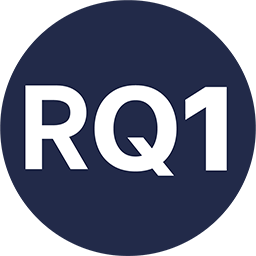 Shraddha Chakradhar recently appeared on CBS News to discuss research she had written about, and we have a republishing partnership with RQ1, a newsletter focused on academic journalism research. “If there is one organization single-handedly responsible for translating academic research on polcomm and journalism to the interested public, it’s Nieman Lab,” Nikki Usher, a journalism professor at the University of Illinois, tweeted this year.
Shraddha Chakradhar recently appeared on CBS News to discuss research she had written about, and we have a republishing partnership with RQ1, a newsletter focused on academic journalism research. “If there is one organization single-handedly responsible for translating academic research on polcomm and journalism to the interested public, it’s Nieman Lab,” Nikki Usher, a journalism professor at the University of Illinois, tweeted this year.
 The Lab’s most important social outreach platform remains email, with its daily and weekly email newsletters reaching nearly 85,000 people. The Lab’s social accounts on Twitter, Facebook, and LinkedIn have nearly 500,000 followers among them, and Nieman Lab’s Twitter account hit 304,000 followers this year. Nieman Lab stories are also regularly cited by dozens of leading publications; this year our coverage was mentioned by The New York Times, The Atlantic, CNN, NPR, Bloomberg and The New Republic, as well as industry press outlets like CJR, Pew, API, Poynter and the Knight-Cronkite News Lab.
The Lab’s most important social outreach platform remains email, with its daily and weekly email newsletters reaching nearly 85,000 people. The Lab’s social accounts on Twitter, Facebook, and LinkedIn have nearly 500,000 followers among them, and Nieman Lab’s Twitter account hit 304,000 followers this year. Nieman Lab stories are also regularly cited by dozens of leading publications; this year our coverage was mentioned by The New York Times, The Atlantic, CNN, NPR, Bloomberg and The New Republic, as well as industry press outlets like CJR, Pew, API, Poynter and the Knight-Cronkite News Lab.
Here’s a sampling of the top stories Nieman Lab published this year:
 “Why do people cancel news subscriptions? We asked, they answered.” (A survey of more than 500 people, and an example of the type of original research that we will publish more of in 2022.)
“Why do people cancel news subscriptions? We asked, they answered.” (A survey of more than 500 people, and an example of the type of original research that we will publish more of in 2022.)- “The end of ‘click to subscribe, call to cancel’? One of the news industry’s favorite retention tactics is illegal, FTC says.”
- “It’s time to create an alternate path into a journalism career.”
- “When it comes to media credits and bylines, men still take the lion’s share.”
- “Cleveland’s Plain Dealer decided to ‘completely ignore’ politicians’ ‘false statements and stunts.’ It’s working.”
- “‘Clickbait gussied up as high-minded trendy woke bullshit’: The White Lotus casts its critical gaze on digital journalism.”
- “Politico is being sold for more than $1 billion. Here are some of the smart movesit made t
 o get there.”
o get there.” - “Subtext lets journalists build deeper relationships with readers, one text at a time.”
- “The New York Times is so done with its 77,000-member Facebook cooking group. What happens now?”
The year ended, as it has each year since 2011, with a collection of predictions for the new year in journalism, written by a diverse group of smart digital thinkers and doers.
Nieman Reports
 2021 was a year that challenged news organizations with a number of complex and structural questions. From the Jan. 6 insurrection at the U.S. Capitol to the ongoing recalibration of covering law enforcement and the disintegrating trust in the news media in general, the journalism industry had much to grapple with. Throughout the year, Nieman Reports, which has been covering thought leadership in journalism since 1947 with an editorial mission “to promote and elevate the standards of journalism,” published insightful, timely, and deeply reported analyses of and commentary on these issues and more.
2021 was a year that challenged news organizations with a number of complex and structural questions. From the Jan. 6 insurrection at the U.S. Capitol to the ongoing recalibration of covering law enforcement and the disintegrating trust in the news media in general, the journalism industry had much to grapple with. Throughout the year, Nieman Reports, which has been covering thought leadership in journalism since 1947 with an editorial mission “to promote and elevate the standards of journalism,” published insightful, timely, and deeply reported analyses of and commentary on these issues and more.
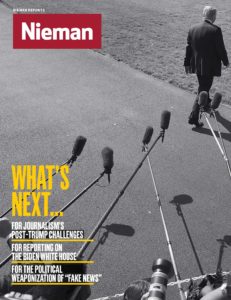 The cover story of the Winter 2021 issue was “For Political Reporters, The Post-Trump Era Poses Practical—and Existential—Questions,” by Allegra Hobbs, one of our longtime contributors. That piece explored why the worst excesses of the Trump era, hallmarked by lies, thinly veiled calls for violence and feuds with the press, would not go away. A companion piece, “Challenges and Possible Solutions to Winning Back Trust in Journalism Post-Trump,” highlighted ways news organizations are responding to the challenges of media mistrust, conspiracy theories, and journalism’s economic sustainability. Another feature, “How Journalists Beyond the U.S. Fight Back Against Government Intimidation,” looked at four countries — Belarus, Jordan, Thailand and Nicaragua — to show how journalists around the world are dealing with “fake news campaigns” and worse. This edition also examined abortion coverage in “Covering Abortion as a Personal Health Care Issue, and Not Just a Political One.” Our story “In Lebanon, a Bold New Era for Accountability Journalism,” laid out how the country is cultivating a “vibrant media landscape” thanks to dozens of privately-owned news outlets.
The cover story of the Winter 2021 issue was “For Political Reporters, The Post-Trump Era Poses Practical—and Existential—Questions,” by Allegra Hobbs, one of our longtime contributors. That piece explored why the worst excesses of the Trump era, hallmarked by lies, thinly veiled calls for violence and feuds with the press, would not go away. A companion piece, “Challenges and Possible Solutions to Winning Back Trust in Journalism Post-Trump,” highlighted ways news organizations are responding to the challenges of media mistrust, conspiracy theories, and journalism’s economic sustainability. Another feature, “How Journalists Beyond the U.S. Fight Back Against Government Intimidation,” looked at four countries — Belarus, Jordan, Thailand and Nicaragua — to show how journalists around the world are dealing with “fake news campaigns” and worse. This edition also examined abortion coverage in “Covering Abortion as a Personal Health Care Issue, and Not Just a Political One.” Our story “In Lebanon, a Bold New Era for Accountability Journalism,” laid out how the country is cultivating a “vibrant media landscape” thanks to dozens of privately-owned news outlets.
 The Spring 2021 issue’s central focus was on covering police and examining racist structures and legacies. For the cover, “Spurred by Black Lives Matter, Coverage of Police Violence Is Changing,” Adeshina Emmanuel wrote about how newsrooms are shifting from centering police narratives to the stories of those impacted by police violence. In “To Change Its Future, The Kansas City Star Examined Its Racist Past,” Mará Rose Williams recounted how the paper came to issuing an apology for mistreating Black Kansas Citians and investigated the deeply racist coverage the paper had published. We also examined how crime stories can follow a person throughout their life in the article “With Fresh Start, The Boston Globe Weighs News Value of Older Articles Versus Individual Harm,” and gave some practical advice about understanding the barriers to finding a wide array of sources in “4 Ways to Increase the Diversity of Your Sources.” Other features in the issue included, “In India, Journalists ‘Are Fighting For Whether Truth is Meaningful or Not,” “After the Capitol Riot, Journalists Content with Rage against the Media,” and “With the Loss of Physical Newsrooms, How are Young Journalists Faring?”
The Spring 2021 issue’s central focus was on covering police and examining racist structures and legacies. For the cover, “Spurred by Black Lives Matter, Coverage of Police Violence Is Changing,” Adeshina Emmanuel wrote about how newsrooms are shifting from centering police narratives to the stories of those impacted by police violence. In “To Change Its Future, The Kansas City Star Examined Its Racist Past,” Mará Rose Williams recounted how the paper came to issuing an apology for mistreating Black Kansas Citians and investigated the deeply racist coverage the paper had published. We also examined how crime stories can follow a person throughout their life in the article “With Fresh Start, The Boston Globe Weighs News Value of Older Articles Versus Individual Harm,” and gave some practical advice about understanding the barriers to finding a wide array of sources in “4 Ways to Increase the Diversity of Your Sources.” Other features in the issue included, “In India, Journalists ‘Are Fighting For Whether Truth is Meaningful or Not,” “After the Capitol Riot, Journalists Content with Rage against the Media,” and “With the Loss of Physical Newsrooms, How are Young Journalists Faring?”
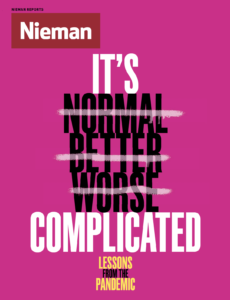 Published as the Covid-19 pandemic entered it 19th month, the Summer/Fall 2021 double issue examined what journalism should look like in the wake of the coronavirus. Our Lessons from the Pandemic cover package included pieces that took a deep look at how photojournalists have adapted, the importance of obituary writing and why education reporters need to work harder to find the students and families most affected by inequality. The edition also included a piece that argued the mainstream press needs to cover more than just the devastation that Covid wrought on Native American communities. In this wide-ranging double issue, Nieman Reports explored the importance of community and immigrant-serving media outlets in “Serving Audiences Mainstream Newsrooms Don’t” and introduced readers to newsrooms dedicated to Latinx audiences in “Get to Know the Newsrooms Focused on Elevating Latinx Voices in the U.S.” “Alexei Navalny, Social Media, and the State of the Free Press in Russia” provided an in-depth look at how the space for independent journalism in the country is shrinking. Nieman Reports also took a hard look at how health reporters have tried to hold elected leaders accountable for their failures in responding to the Covid-19 crisis, documenting the devastating toll, and balancing the impact of their job and the pandemic on their own lives.
Published as the Covid-19 pandemic entered it 19th month, the Summer/Fall 2021 double issue examined what journalism should look like in the wake of the coronavirus. Our Lessons from the Pandemic cover package included pieces that took a deep look at how photojournalists have adapted, the importance of obituary writing and why education reporters need to work harder to find the students and families most affected by inequality. The edition also included a piece that argued the mainstream press needs to cover more than just the devastation that Covid wrought on Native American communities. In this wide-ranging double issue, Nieman Reports explored the importance of community and immigrant-serving media outlets in “Serving Audiences Mainstream Newsrooms Don’t” and introduced readers to newsrooms dedicated to Latinx audiences in “Get to Know the Newsrooms Focused on Elevating Latinx Voices in the U.S.” “Alexei Navalny, Social Media, and the State of the Free Press in Russia” provided an in-depth look at how the space for independent journalism in the country is shrinking. Nieman Reports also took a hard look at how health reporters have tried to hold elected leaders accountable for their failures in responding to the Covid-19 crisis, documenting the devastating toll, and balancing the impact of their job and the pandemic on their own lives.
Other highlights from our online-only stories ranged from opinion pieces on how reporters can better manage the uncertainty inherent in scientific research and how journalists can move forward in this age of disinformation to interviews with Nieman alumni and authors like Joshua Prager, who discussed his latest book “The Family Roe: An American Story.” We also explored how rural news outlets are trying to bridge the information divide as the industry contracts and more local papers close. We also published a call for Belarus President Aleksandr Lukashenko to allow the press in his country to operate without fear of reprisals after officials diverted an international flight to arrest a dissident as well as a look at how NPR could be more inclusive and diverse and a piece on how to expand independent local news.
 This year, Nieman Reports articles won two Mirror Awards, which honor excellence in media industry reporting. Opinion columnist Issac Bailey, NF ’14, won the commentary award for three of his opinion pieces and reporter Casey Quackenbush won the award for “Best Story on Media Coverage of the 2020 Presidential Election” for “Without a Campaign to Cover, Reporters Shift to Covering the Voting Process Itself.” Deborah Douglas was named as a finalist in the best single article/story category for “Meet the New Black Press.”
This year, Nieman Reports articles won two Mirror Awards, which honor excellence in media industry reporting. Opinion columnist Issac Bailey, NF ’14, won the commentary award for three of his opinion pieces and reporter Casey Quackenbush won the award for “Best Story on Media Coverage of the 2020 Presidential Election” for “Without a Campaign to Cover, Reporters Shift to Covering the Voting Process Itself.” Deborah Douglas was named as a finalist in the best single article/story category for “Meet the New Black Press.”
Using a social media strategy focused on posting during peak hours and new visual templates, Nieman Reports saw an increase in visitors compared to last year. On Facebook, Nieman Reports now reaches 7,037 followers while on Twitter, followers have increased to 36,781. The site has also seen a 7% growth in users visiting the site from search compared to last year and the publication’s monthly newsletter added new readers, now reaching a total of 6,553 subscribers.
The staff that produces Nieman Reports includes editor James Geary, deputy curator of the Nieman Foundation; senior editor Laura Colarusso; assistant editor Natalie DeRosa; and publisher Ann Marie Lipinski, curator of the Nieman Foundation; with design by Dan Zedek, a Boston-based independent designer.
Nieman Storyboard
The question has circulated since the rise of digital media, then intensified as the legacy press — both newspapers and magazines — faced financial crises: Is narrative journalism dead?
There is no question that cultural and economic pressures pushed news organizations to redouble their focus on accountability journalism: monitoring and watchdogging government and power on behalf of the public they are meant to serve. But a quick scan of the journalism landscape — both legacy and digital native — belies the concerns: Narrative storytelling, whether short- or longform, is more in demand than ever, and more journalists are intent on learning to do it with a blend of credibility, ethics and elegance.
Nieman Storyboard holds a special place in what is an increasing crowded field. What started as a simple listserv newsletter to attendees of the former Nieman Narrative Conference — the nation’s premier such gathering — eventually became a digital publication dedicated to exploring the art and craft of story.
Nieman Storyboard not only highlights good work being done, but explores how work was done through interviews with the bylined journalists, analyses by other top journalists and expert annotations of the stories.
Of note:
- We will close the year with at least 24 Story Annotations, the most involved of Storyboard posts and also the ones with the most sustained interest overtime, sought out by educators, students and working journalists. We have expanded annotations beyond classic longform (a New Yorker piece by Larissa MacFarquhar on the complications of Ultra-Orthodox Jewish divorce) to shorter descriptive narratives (Kim Cross writing an essay for The New York Times about the “freedom” she found in Freedom, Wyoming) to personal essays and introspections (Lisa Grace Lednicer of The Washington Post annotating her own 9/11 column of 20 years ago).
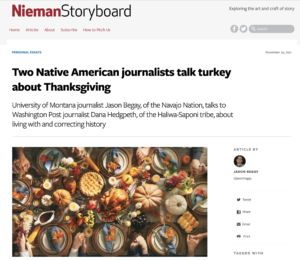 Two writers talked to each other about what they learned from baking pie, while two others exchanged stories about their respective Native American childhoods and perspective on how we write about Thanksgiving.
Two writers talked to each other about what they learned from baking pie, while two others exchanged stories about their respective Native American childhoods and perspective on how we write about Thanksgiving.- We have added more Personal Essays, but always ensure they have strong foundation of teaching/learning for other journalists.
- With Narrative News, we updated narrative conferences and workshops as another year of COVID kept schedules in chaos. We also updated work featured in previous posts as it won awards or landed a coveted book contract or, sadly, involved the death of one of the masters of this craft.
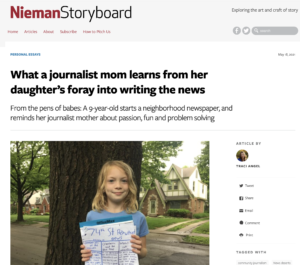 A retired newspaper journalist wrote about what he has discovered from writing essays while camping in the wilderness, a freelancer explores what she learned when her 9-year-old daughter launched a neighborhood newspaper about pets and a transgender journalist offered advice on what not to ask in an interview with a transgender person.
A retired newspaper journalist wrote about what he has discovered from writing essays while camping in the wilderness, a freelancer explores what she learned when her 9-year-old daughter launched a neighborhood newspaper about pets and a transgender journalist offered advice on what not to ask in an interview with a transgender person.- We worked to make Story Craft posts an essential go-to for journalism educators and students. A two-week series on how to teach and coach the nut graf was shared and shared again by educators. We completed our series on the 7 Fatal Flaws of Story Pitches.
- We also ventured more into digital work. A two-part post annotated a print piece that was the foundation for a “This American Life” episode and a Netflix series. A five-part series about solo video storytelling, “Field Testing,” by 2020 Nieman Fellow Alexander Trowbridge, was a finalist in the 2021 ONA Awards.

Alexander Trowbridge waves to his drone in this clip from "Field Testing."
- Finally, we are plugging into the exciting and increasing merger between the worlds of investigative and narrative journalism. What for too long lived on opposite ends of the story spectrum are now meeting in the middle as more narrative journalists seek to deepen their sourcing, and more investigative journalists seek to make their pieces both unflinching and compelling. Examples: A Washington Post project by John Woodrow Cox on the collateral damage of gun violence to children; Lizzie Presser of ProPublica on the scandal of unneeded amputations of Black diabetes patients.
All this reinforces the mission of helping journalists use all the tools available to do the work necessary for our times. No analytics can measure the full impact of stories, or story work, on readers, listeners or viewers. But our measurable foundation growth included a longer time spent on page compared to last year, indicating a deeper, more engaged audience.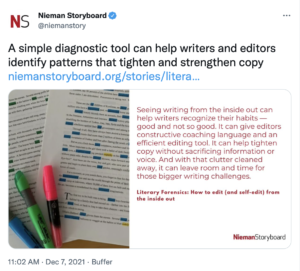
On social media, due to a strategy emphasizing consistent posting during peak hours and a focus on sharing stories in like-minded online community groups, Storyboard saw an increase in visitors from social media compared to last year. On Facebook, Storyboard’s account reached 5,778 followers while on Twitter, followers increased to 16,634. And the site’s weekly newsletter, which is sent each Friday afternoon, added new readers and now reaches a total of 13,825 subscribers.
Jacqui Banaszynski is editor of Nieman Storyboard. She was assisted in her work in 2021 by Nieman’s digital and audience engagement editors Leah Becerra and Adriana Lacy and by Natalie DeRosa, assistant editor of Nieman Reports.

